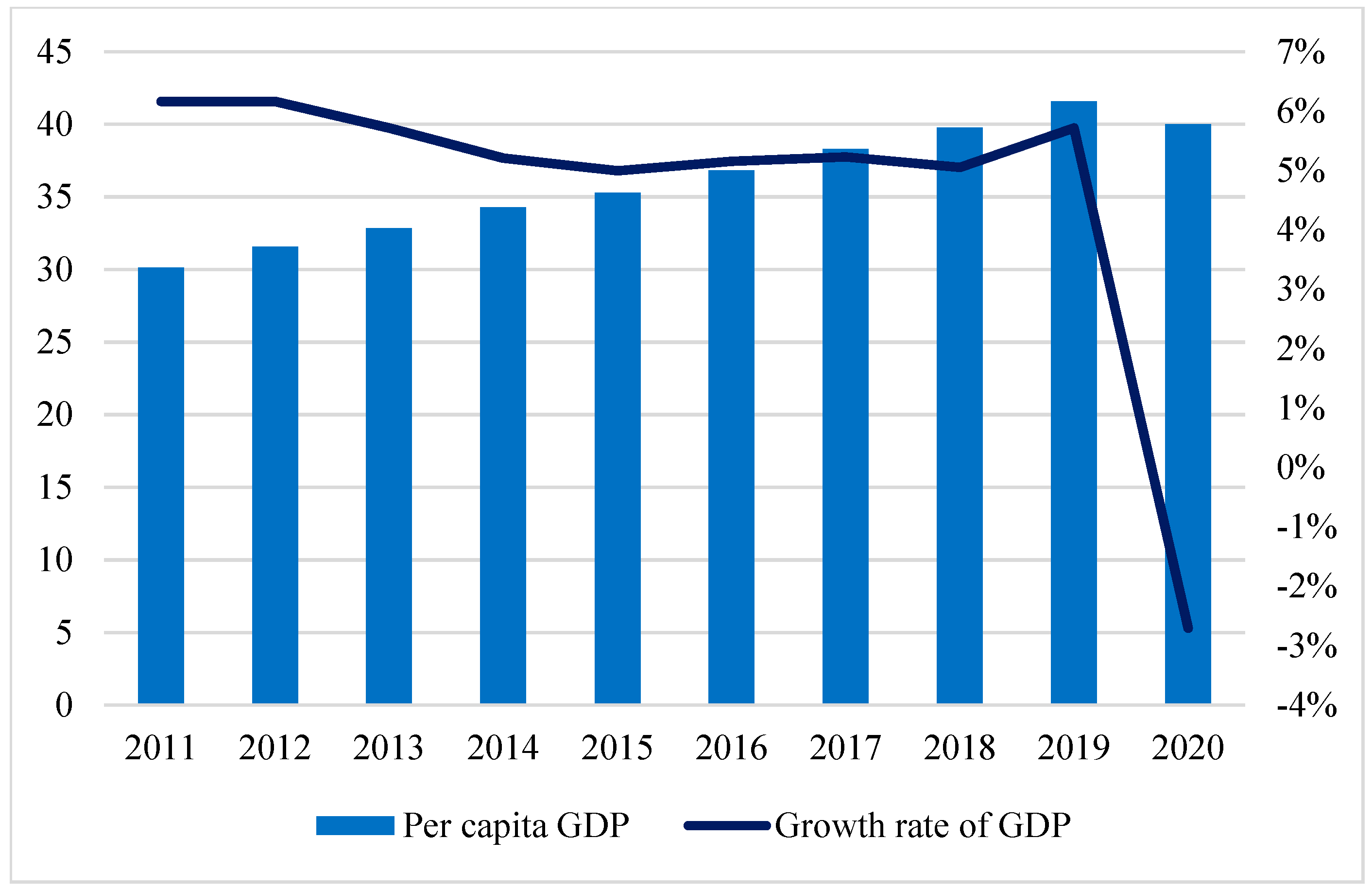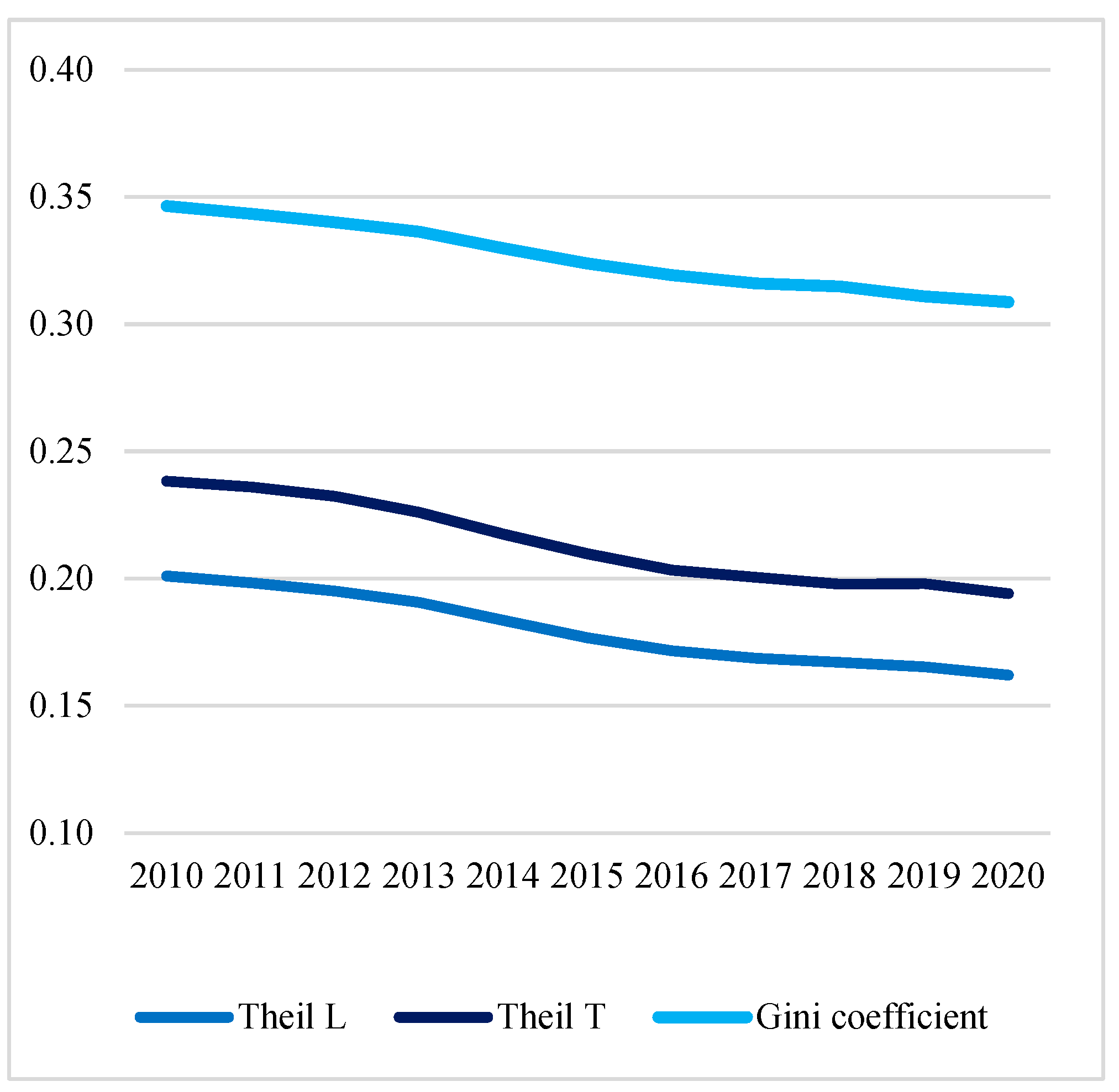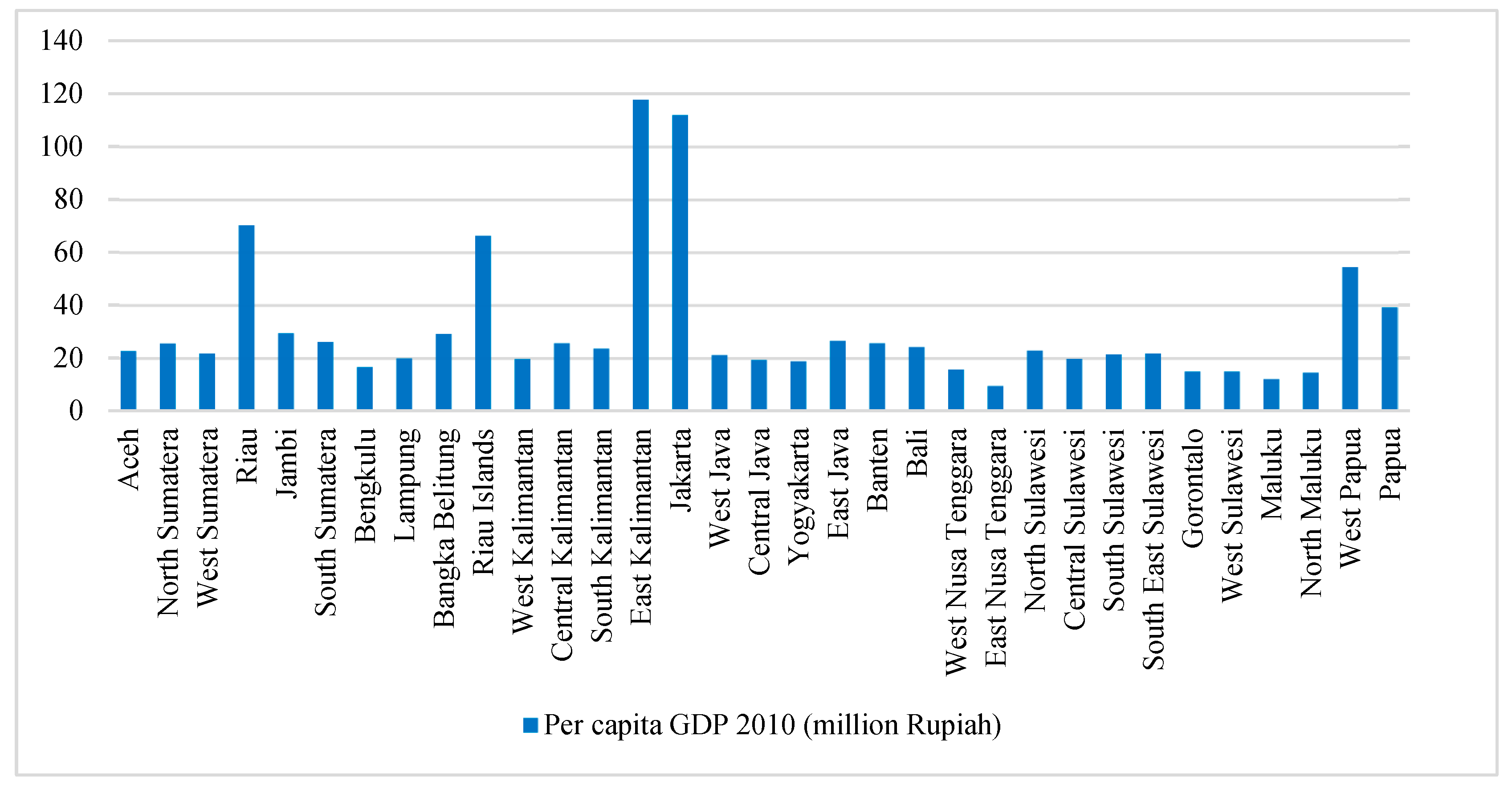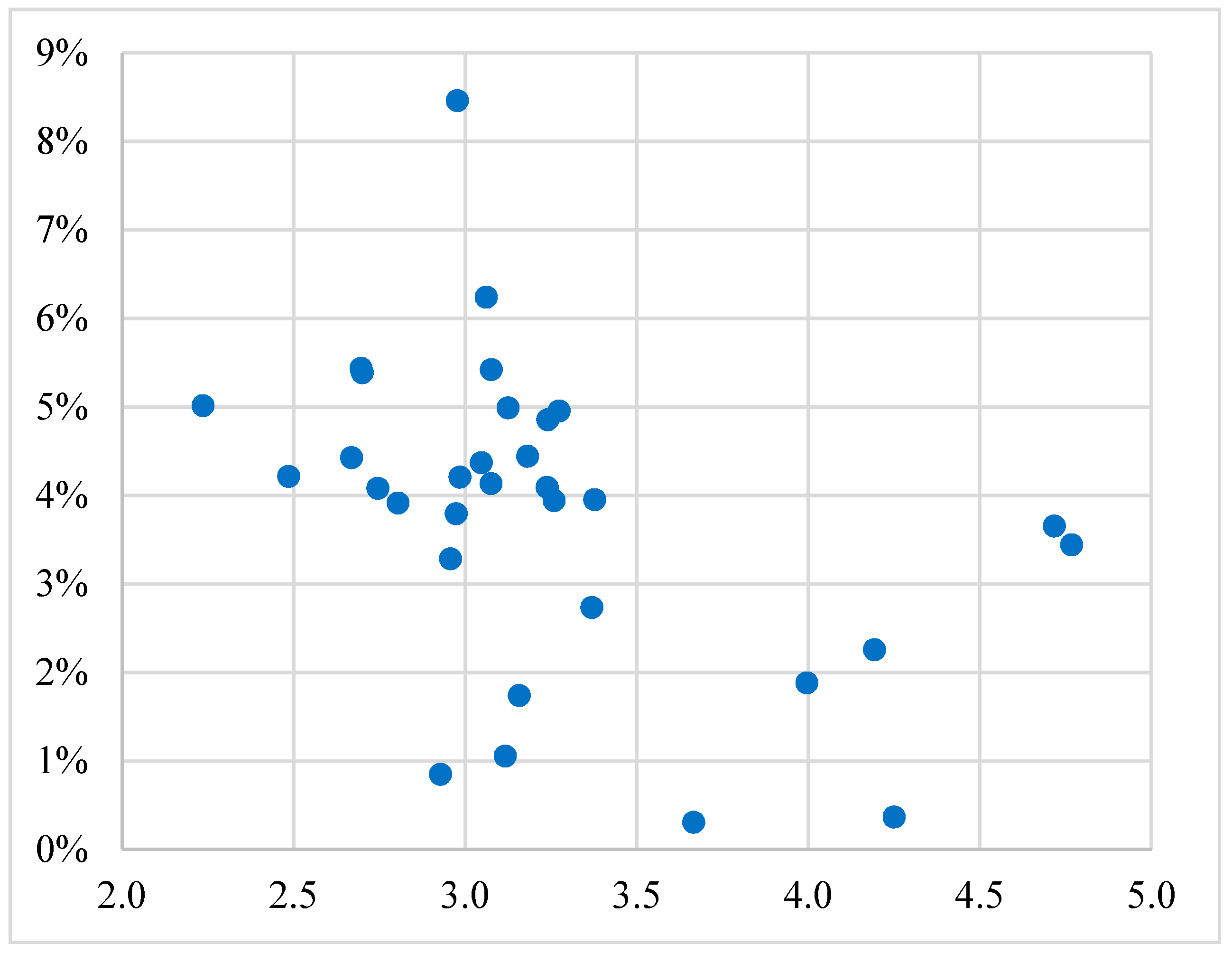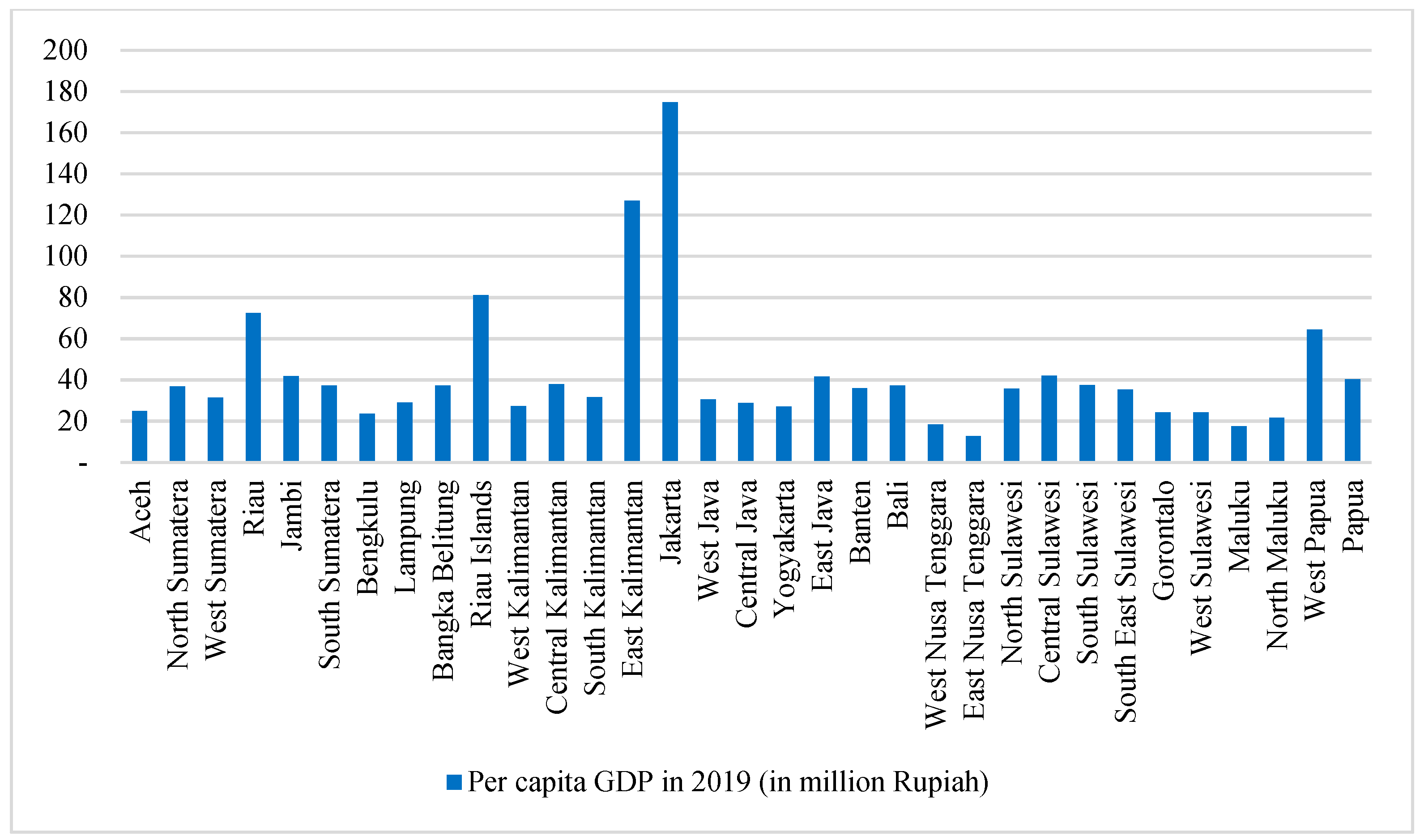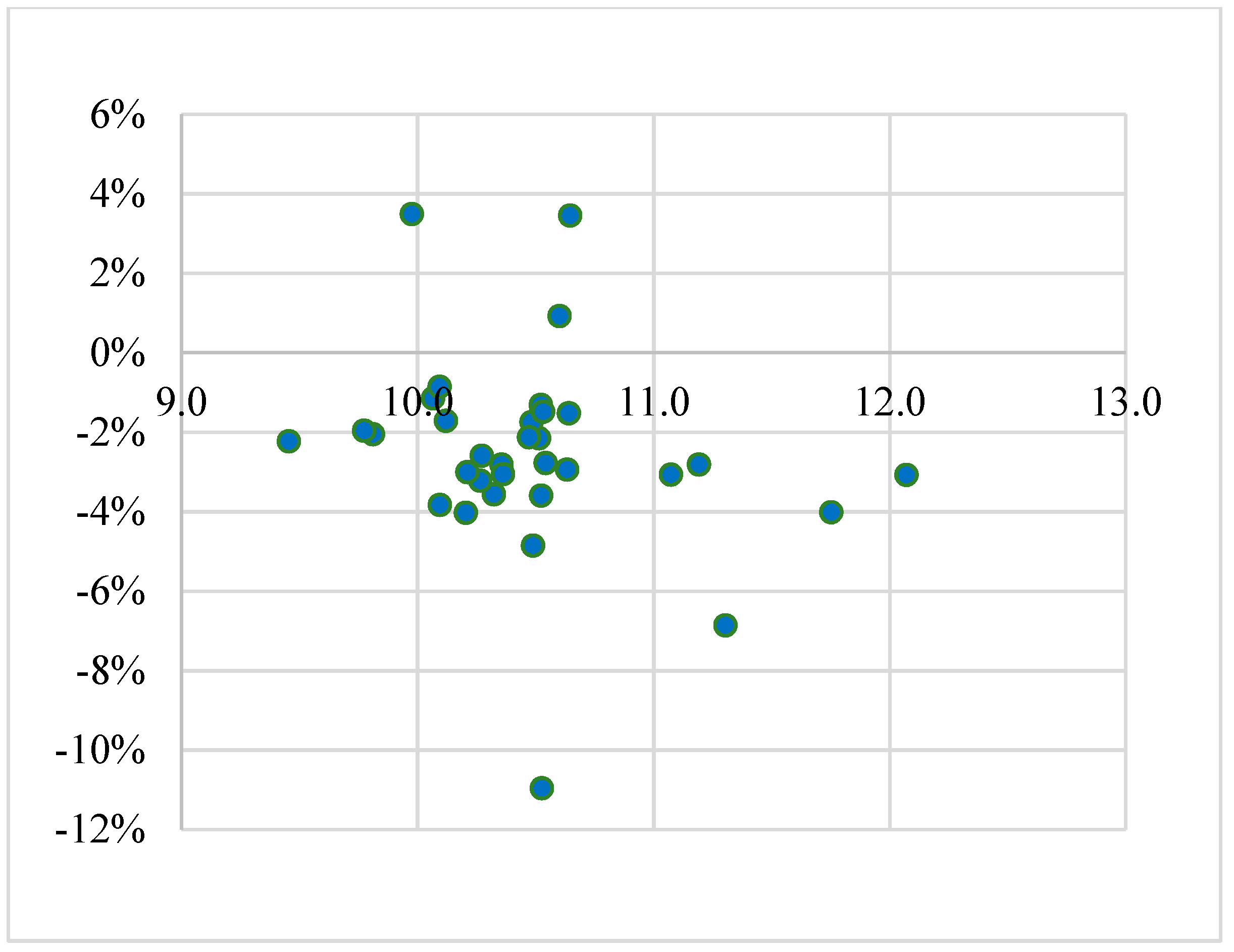1. Introduction
Since the outbreak of the novel coronavirus disease (COVID-19) in early 2020, the number of confirmed COVID-19 cases has increased exponentially in Indonesia. As of August 2021, 4.1 million people have been infected, meaning that at least 15 out of 1000 people have been infected. The COVID-19 pandemic hit the Indonesian economy severely. In 2020, real GDP decreased by 2.7% (
Figure 1). Since the annual average growth rate was 5.3% between 2010 and 2019, the impact of the COVID-19 pandemic has been enormous. The COVID-19 pandemic had, however, differential impacts on regional economies (
Figure 2). While tourist destination provinces such as Bali and Riau Islands experienced a large decrease in per capita GDP, the impact appears to have been relatively small in such eastern provinces as Central Sulawesi, North Maluku and Papua (see
Figure 3 for a map of Indonesia).
How has the COVID-19 pandemic affected regional economies? How have structural changes caused by the COVID-19 pandemic affected the determinants of regional income inequality? This study addresses these questions using provincial GDP for industrial sectors in Indonesia. It uses a bi-dimensional inequality decomposition method to explore the determinants of inter-provincial inequality in per capita GDP before and after the outbreak of COVID-19. The bi-dimensional inequality decomposition method employs a squared population-weighted coefficient of variation (squared
WCV) as a measure of inequality and decomposes inter-provincial inequality in per capita GDP along two dimensions: by region and by GDP components (The population-weighted coefficient of variation, introduced by Williamson [
2], has been used by many researchers to measure regional income inequality. See, for example, Mathur [
3], Tabuchi [
4], Mutlu [
5], Akita and Lukman [
6], Fujita and Hu [
7], and Hill and Vidyattama [
8]). The squared
WCV satisfies several desirable properties as a measure of inequality, such as anonymity, income homogeneity, population homogeneity and the Pigou–Dalton transfer principle (Anand, [
9]; Fields [
10]). Since the squared
WCV is a member of the generalized entropy class of inequality measures, inter-provincial inequality in per capita GDP, as measured by the squared
WCV, can be decomposed additively by region; that is, decomposed into within-region and between-region inequality components (Shorrocks [
11]) (Here, provinces are classified into mutually exclusive and collectively exhaustive regions.). Furthermore, using the squared
WCV, inter-provincial inequality can be decomposed by GDP components; that is, expressed as the sum of contributions from GDP components (Shorrocks, [
12]) (Here, total GDP consists of several GDP components (GDP from several industrial sectors).). Using the squared
WCV, the bi-dimensional inequality decomposition method combines these two decomposition properties. It can thus analyze the contribution of each GDP component to overall inter-provincial inequality in GDP per capita through within-region and between-region inequalities in a coherent framework.
The next section provides a literature review pertaining to our study.
Section 3 presents the data and the methods used in this study.
Section 4 discusses the results, while
Section 5 provides concluding remarks.
2. Literature Review
To the best of our knowledge, only a few studies have investigated the impact of the COVID-19 pandemic on the distribution of income in Indonesia. (Following the completion of this paper, several additional articles addressing the impacts of the COVID-19 on income inequality have been published. They include Brata et al. [
13], Suryahadi, et al. [
14], and Novianti and Panjaitan [
15], but they differ from our study in both methodology and data.) Suryahadi, et al. [
16] estimated the impact of the pandemic on poverty in Indonesia by conducting a simulation analysis based on the past pattern of economic shocks. They found that under the worst-case scenario of economic growth, in which the economy contracts by 3.5%, the poverty headcount ratio increases from 9.2% in 2019 to 16.6% by the end of 2020. This means that 19.7 million people become poor, bringing the country back to 2004, when the poverty headcount ratio was 16.7%.
Gibson and Olivia [
17] also investigated the impact of the COVID-19 pandemic on poverty in Indonesia. Unlike Suryahadi, et al. [
16], they estimated the impact at the provincial level using mobility data from Google. They found that the impact varied substantially across provinces. Provinces with lower initial poverty headcount ratios tended to have a larger increase in the headcount ratio. For example, in Bali, one of the richest provinces, the poverty headcount ratio increased by 13 percentage points, while in the poorest provinces of Papua and East Nusa Tenggara, it increased by 3 percentage points. They thus argued that the social assistance program needed to be expanded in places where people had not widely relied on it previously.
On the other hand, numerous studies have been conducted to analyze regional income inequality in Indonesia using provincial GDP because a large income disparity has persisted between provinces. (In 2022, Jakarta had the largest per capita GDP at 298 million Rupiah, which was 14 times the smallest in East Nusa Tenggara.) These studies include Esmara [
18], Akita and Lukman [
6], Garcia and Soelistianingsih [
19], Hill, et al. [
20], Vidyattama [
21], Hill and Vidyattama [
8], and Alisjahbana and Akita [
22].
Akita and Lukman [
6] used provincial GDP by industrial sector to explore the determinants of inequality in per capita GDP from 1975 to 1992. They conducted an inequality decomposition analysis by industrial sector using the
WCV. Hill and Vidyattama [
8] used an updated dataset of provincial GDP to analyze inequality in per capita GDP from 1975 to 2010. On the other hand, Garcia and Soelistianingsih [
19] investigated
-convergence using provincial GDP from 1975 to 1993. Hill, et al. [
20] also examined
-convergence using an updated provincial GDP data set from 1975 to 2002. Vidyattama [
21] employed a spatial econometric approach to investigate the impact of the neighborhood effect on the speed of
-convergence using provincial- and district-level GDP from 1999 to 2008.
Alisjahbana and Akita [
22] used provincial GDP by industrial sector from 2005 to 2013 to examine how economic tertiarization and concurrent output deindustrialization have affected the determinants of inter-provincial inequality in per capita GDP by conducting a bi-dimensional inequality decomposition analysis. Our study is similar to this study in terms of method, involving the assessment of regional sustainability from two dimensions: economic and spatial development (see Shmelev and Shmeleva [
23]). But, it uses provincial GDP by industrial sector from 2010 to 2020 and analyzes the initial impacts of the COVID-19 pandemic on inter-provincial inequality in per capita GDP.
Our study also differs from that of Alisjahbana and Akita [
22] in that it uses a 52-sector classification, while Alisjahbana and Akita [
22] used 33-sector classifications (see
Table 1 for the sector classifications). Thus, our study could analyze the impact of structural changes on inter-provincial inequality in greater detail. With 33-sector classifications, we are not able to analyze structural changes within the manufacturing sector. In the 33-sector classification, the manufacturing sector consists of two subsectors: oil and gas manufacturing and non-oil and non-gas manufacturing, while it contains 16 subsectors in the 52-classification (see
Table 1). The manufacturing sector has served as the engine of growth and played an important role in regional economies. With 16 subsectors, therefore, our study provides much better insights into the role of the manufacturing sector in inter-provincial income inequality.
5. Concluding Remarks
Based on provincial GDP across industrial sectors, this study investigated how structural changes caused by the pandemic have affected the determinants of inter-provincial inequality in per capita GDP by conducting a bi-dimensional inequality decomposition analysis.
The major findings are summarized as follows: First, inter-provincial inequality in per capita GDP, as measured by the Gini coefficient and the Theil indices, has been decreasing over the study period of 2010–2020. Before the COVID-19 pandemic (2010–2019), relatively poor Sulawesi provinces grew faster than other provinces, while resource-rich provinces (such as Aceh, Riau, East Kalimantan, and Papua) were stagnant, indicating there was absolute β-convergence across Indonesian provinces. In contrast, no absolute β-convergence was observed across these provinces during the pandemic (2019–2020), though this does not rule out the possibility of conditional β-convergence.
Second, the results of a bi-dimensional inequality decomposition analysis show that before the outbreak of COVID-19, the Java-Bali region (region 2) raised its contribution to overall inter-provincial inequality from 61% to 77%. The IC (information and communication), financial services, and business services sectors were mainly responsible for this increase; these three sectors had very large inter-provincial inequalities and grew very rapidly in region 2. On the other hand, the Sumatra and Kalimantan region (region 1) lowered its contribution to overall inequality from 34% to 18%. The main contributors were the mining sector and the coal and refined petroleum products sector. While these two sectors had very large inter-provincial inequalities, they lowered their GDP shares substantially in region 1, resulting in a large reduction in their contributions to overall inequality.
Third, after the outbreak of COVID-19, the hotel and restaurant sector, one of the tourism sectors, lowered its contribution to overall inter-provincial inequality prominently. Region 2 was responsible for this decrease, where the sector contracted substantially (−14%), and its GDP share declined. Other tourism sectors, such as textile and apparel, transport equipment, and air transportation, also contracted substantially and lowered their contributions. In contrast, the IC and financial services sectors were not affected by the pandemic and raised their contributions to overall inequality. These two sectors had high inter-provincial inequality, particularly in region 2. They have played an increasingly important role in determining overall inequality. Owing to increasing demands for health services, the health services sector grew very rapidly, but its contribution to overall inequality was not large. On the other hand, the business services sector was severely affected by the pandemic. It experienced a negative growth and lowered its contribution. However, with its very large inter-provincial inequality in region 2, it still serves as one of the main contributors to overall inequality.
The COVID-19 pandemic has exerted an enormous impact on the Indonesian economy. In 2020, the country contracted by 2.7% in real GDP. But, the impact has been spatially heterogeneous. Many provinces, particularly those relying on tourism, experienced large negative growth, while some poorer provinces in the eastern part of Indonesia escaped severe economic downturn. This finding is consistent with those of a study conducted by Gibson and Olivia [
17], in which richer provinces with lower initial poverty headcount ratios, such as Bali and Riau Islands, tended to exhibit a larger increase in poverty incidence, while poorer provinces in the eastern part of Indonesia, such as Central Sulawesi, Papua, and North Maluku, tended to experience a smaller increase in poverty incidence.
When Indonesia recovers from the pandemic, an important policy question is whether inter-provincial inequality in per capita GDP will further decrease or not. Another important policy question is which industrial sectors will serve to determine inter-provincial inequality. It is likely that the mining sector and the coal and refined petroleum products sector will further reduce their significance as their GDP shares will decrease. It is also likely that the tourism sector will regain its position as an important determinant of inter-provincial inequality. However, the most important sectors in determining inter-provincial inequality will be the IC, financial, and business services sectors. With the rapid advancement of IC, financial, and e-business technologies, the roles of these high-inequality services sectors are likely to increase in determining inter-provincial inequality, unless policies that could facilitate spatial dispersion of these services and activities are implemented. On the other hand, the manufacturing sector is likely to reduce inter-provincial inequality as the GDP share of inequality-reducing manufacturing sectors such as food processing will increase.
While our study provides valuable insights into the initial impacts of the COVID-19 pandemic on inter-provincial income inequality, it is not without limitations. First, the bi-dimensional inequality decomposition method that we employed is descriptive. Thus, in future research, we plan to conduct an econometric analysis using panel data for 33 provinces to assess the effects of the pandemic on provincial economies. Second, due to the unavailability of provincial GDP data for the 52 industrial sectors for the period after 2021, we could not analyze the extended effects of the COVID-19 pandemic on inter-provincial income inequality in a comparable analytical framework. Thus, we plan to conduct further research to investigate the longer-term effects using provincial GDP data for the 52 industrial sectors for the period from 2019 to 2023.
